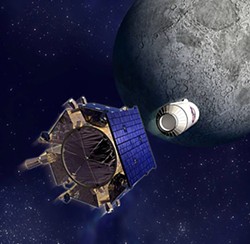[
{
"name": "Top Stories Video Pair",
"insertPoint": "7",
"component": "17087298",
"parentWrapperClass": "fdn-ads-inline-content-block",
"requiredCountToDisplay": "1"
}
]
I'm jazzed about NASA's latest venture to the moon, which was launched last Thursday afternoon June 18. The main mission, the Lunar Reconnaissance Orbiter (LRO), is a robotic spacecraft with the primary objective of surveying lunar resources and identifying possible landing sites for the next, long-overdue human mission, slated for 2020.
LRO is a sophisticated spacecraft destined to fly in a polar lunar orbit as as it maps the entire surface. In addition to super-high resolution photography (it will be able to detect gear left from the Apollo years), LRO will be measuring deep space radiation in the lunar environment, as a prelude to an extended human presence on the surface. However, radiation may not be moon-visitors' biggest problem. While astronauts could cover their living quarters with a few feet of lunar soil to absorb gamma rays, they'd be very limited without ready access to the stuff we Humboldt County dwellers take for granted: water. If there was concrete on the moon, we'd mine it for its water content.
Conventional wisdom says that the lunar surface is drier than the Sahara, since sunlight long ago evaporated any lunar water that might have been brought there in the form of icy comets. But what if CW is wrong? That's what NASA mission planners are hoping for, that sheets or tundras of very cold water ice are lying at the bottoms of deep, dark craters at the moon's poles, where the sun never shines.
Which explains the excitement over LRO's "piggy-back" mission, the Lunar Crater Observation and Sensing Satellite (LCROSS). Originally, LRO was a stand-alone mission, but the decision -- made just three short years ago (most mission timelines are for five-10 years) -- to switch to a more powerful Atlas V launch vehicle offered scientists the opportunity to look for water in a more hands-on way. On October 8, LCROSS is scheduled to smash into a polar crater, sending up a plume of -- what? Dust? Water vapor? That's the big question.
It gets better. The final stage of the Atlas rocket precedes the LCROSS on its crash course by four minutes, so whatever gets thrown up by that impact will be observed, in very close detail, by instruments on the LCROSS craft. Not to mention observatories worldwide and countless amateurs hoping to glimpse the two impact clouds. Anyone with a 10-inch or larger telescope has a chance of witnessing history in the making.
Water on the moon? It's a long shot, but it could make all the difference between just visiting and colonizing our local companion in space.
Barry Evans ([email protected]) never thought in 1972 he'd still be waiting 37 years later for people to walk again on the moon. He lives in Old Town Eureka.
Comments
Showing 1-1 of 1
more from the author
-
Doubting Shakespeare, Part 1: Stratfordians vs. anti-Stratfordians
- Apr 25, 2024
-
A Brief History of Dildos
- Apr 11, 2024
-
Eclipse!
- Mar 28, 2024
- More »
Latest in Field Notes
Readers also liked…
-
Trouble on the Line: The Reality Part 2
- Nov 3, 2022

































